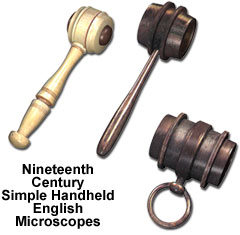English Handheld Simple Microscopes
Before the advent of the achromatic lens by Joseph Jackson Lister in 1826, simple microscopes were generally considered superior scientific instruments than more complicated, but technically flawed compound microscopes. In fact, even after the development of the improved lens, simple magnifiers fashioned from materials such as brass, wood, bone, and ivory continued to be popular with the scientifically curious Victorians.

Illustrated above are three examples of English simple microscopes from the mid-nineteenth century, which are based on photographs and descriptions of the originals in Gerard Turner's volume entitled Collecting Microscopes. The instrument on the far left is an unsigned simple microscope that consists of a Stanhope lens mounted in an ivory, handheld frame. Named after Charles Mahon, the Third Earl of Stanhope, the lens is fashioned out of thick glass and the curvatures of its two surfaces are unsymmetrical, the more convex side being intended to face the user's eye. The handheld instrument in the center of the illustration is made of brass. Developed by Henry Coddington, the lens it contains features a groove around its middle that acts as a lens stop. Shaped fundamentally different than the other two examples, the small brass microscope on the right-hand side of the illustration is designed to hang on a pocket watch chain.
BACK TO NINETEENTH CENTURY MICROSCOPES
